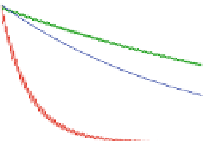Biomedical Engineering Reference
In-Depth Information
Fig. 9.6
The occupation of
the higher energy QD as a
function of time at
T
a
b
1
=
4K:
D
= 3 meV
0.8
D = 8 meV
(
a
)
D
=
8nmand
Δ
as
shown; (
b
)
Δ
=
3 meV and
D
0.6
as shown [
62
]
0.4
D = 10 nm
D
= 4 meV
0.2
D = 6 nm
D
= 2 meV
0
0
0.1
0.2
0.3
0
0.1
0.2
0.3
t
[ns]
t
[ns]
single-exciton states results from the dipole coupling of the Forster type (see
Sect.
9.2
). Such an interaction opens the possibility of a transfer of occupation
between the dots which, in the presence of a dissipation channel, can become
irreversible. For confined carriers, the dissipation is dominated by phonon-related
mechanisms. Such a process was studied using quantum-kinetic equations [
63
,
89
],
perturbative (Fermi golden rule) approaches [
90
,
91
], or Forster phenomenology
[
92
]. Here, we summarize the results of [
63
].
The system is described by the Hamiltonian
H
H
DQD
−
ph
[Eqs. (
9.3
), (
9.4
), and (
9.5
)]. We assume that there is one exciton in the system,
initially localized in one of the dots and use the simple (Gaussian) model of wave
functions. The calculations were originally performed [
63
] within the correlation
expansion approach, outlined in Sect.
9.2.2.3
. However, the lowest-order time-
convolutionless equations (Sect.
9.2.2.1
) yield essentially the same results. As we
will see, the interplay of the coupling and phonon-assisted dissipation leads to
irreversible excitation transfer between the dots, which is due to a weak Coulomb
(Forster) coupling between them.
In general, if the initial state corresponds to the exciton located in one of the
dots (state
=
H
DQD
+
H
ph
+
) the evolution is a combination of conservative (unitary)
oscillations due to the perturbation induced by the coupling
V
and a dissipative,
irreversible transition towards the lower eigenstate of
H
DQD
[
63
,
93
] induced by the
coupling to the phonon continuum. However, in the case of a weak coupling the
oscillations are very small and the occupation of the higher-energy dot follows a
nearly exponential decay, as shown in Fig.
9.6
(here
l
|
01
or
|
10
1nm,and
the interband dipole moment corresponds to 400 ps radiative lifetime) [
62
]. An
interesting feature visible in Fig.
9.6
is that the rate of the excitation transfer is non-
monotonic both in the energy mismatch and in the separation between the dots.
The nearly exponential decay curve suggests that the process can be described
in the Markovian approximation. This is possible, since the typical time scale of
the decay process is long compared to the transition frequency
V
=
4
.
5nm,
l
z
=
h
between the
two single-exciton states. It was shown [
63
] that the formal long-time limit of the
TCL equation for this problem in the rotating wave approximation leads to optical
Bloch equations describing the system dynamics in the interaction picture and in the
rotating frame related to the eigenstates of
H
DQD
.
/




























































